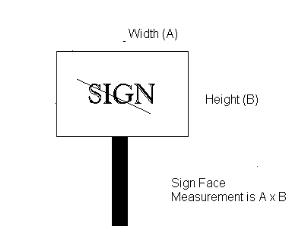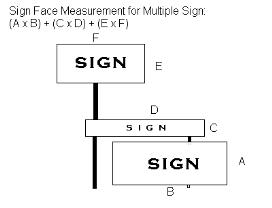Chapter 18.120
SIGN REQUIREMENTS
Sections:
18.120.040 General sign regulations.
18.120.050 Base zone sign regulations.
18.120.080 Nonconforming signs.
18.120.090 Abandoned signs or signs in disrepair.
18.120.100 Administration and enforcement.
18.120.010 Purpose.
This section regulates such factors as the size, number, location, illumination and construction of signs with the intent of safeguarding and enhancing the aesthetic character of Garibaldi. [Ord. 290 § 3(4.050(1)), 2006.]
18.120.020 Conformance.
No sign may be erected unless it conforms with the regulations of this section. Sign permits, as required by GMC 18.120.060, must be approved prior to the placement of the sign. [Ord. 290 § 3(4.050(2)), 2006.]
18.120.030 Exempt signs.
The following signs are exempt from the provisions of this section:
A. Signs within a building not intended to be visible from the exterior of a building.
B. Signs legally erected in a street right-of-way.
C. Three flags of national or state governments. [Ord. 290 § 3(4.050(3)), 2006.]
18.120.040 General sign regulations.
The following general provisions shall govern all signs, in addition to all other applicable provisions pertaining to signs:
A. Sign Face Area.
1. The area of sign faces enclosed in frames or cabinets is determined by the outer dimensions of the frame or cabinet surrounding the sign. Sign area does not include foundations, supports and other essential structures that do not serve as a backdrop or border to the sign. Only one side of a double-faced sign is counted in measuring the sign face area. (To be considered a double-faced sign, the sides of the sign must be flush.)
2. When signs are constructed of individual pieces, the sign area is determined by a perimeter drawn around all the individual pieces taken together.
3. For sign structures containing multiple sign modules oriented in the same direction, the sum of the sign area of the individual sign modules are counted as one sign face.
4. The area of a sign shall be determined according to the following:
a. Rectangle or square: length times width.
b. Triangle: length times width divided by two.
c. Circle: 3.14 times R squared, where R is the sign’s radius.
d. Oval: the area contained within a rectangle whose length times width does not exceed 30 square feet.
e. The city shall measure other sign shapes, not listed above, according to the formula it determines to be most appropriate.
Sign Face Measurement
Figure 1.
Figure 2.
Figure 3.
B. Height of Signs. Signs shall conform to the height requirement of the zone in which they are located. The height of a sign or sign supporting structure is measured from the existing grade directly below the sign to the highest point of the sign or sign supporting structure.
C. Clearances. Clearances are measured from the existing grade directly below the sign to the bottom of the sign structure enclosing the sign face.
D. Sign Placement.
1. Placement. All signs and sign structures shall be erected and attached totally within the site, except where permitted to extend into a street right-of-way.
2. Frontages. Signs allowed based on the length of one site frontage may be placed on another site frontage.
3. Vision Clearance Areas. No sign may be located within a clear vision area as defined in GMC 18.95.010.
4. Vehicle Area Clearances. When a sign extends over a private area where vehicles travel or are parked, the bottom of the sign structure shall be at least 14 feet above the ground. Vehicle areas include driveways, parking lots, and loading and maneuvering areas.
5. Pedestrian Area Clearances. When a sign extends over sidewalks, walkways or other spaces accessible to pedestrians, the bottom of the sign structure shall be at least eight feet above the grade.
6. Projecting Signs. Signs shall not project into a public right-of-way, except over a sidewalk. Where a sign projects over a sidewalk, it may project within two feet of the outside edge of the sidewalk.
E. Signs Not to Constitute a Traffic Hazard. Signs or sign supporting structures shall not be located so as to detract from a motorist’s view of vehicular or pedestrian traffic or a traffic sign.
F. Glare. All signs shall be so designed and located so as to prevent the casting of glare or direct light from artificial illumination upon adjacent publicly dedicated streets and surrounding public or private property.
G. Prohibited Signs. The following signs are prohibited:
1. Signs that contain flashing elements.
2. Signs that contain moving, rotating or otherwise animated parts.
H. Maintenance. All signs, together with their supporting structures, shall be kept in good repair and maintenance. Signs shall be kept free from corrosion, peeling paint or other surface deterioration. The display surfaces of all signs shall be kept in a neat appearance.
I. Removal of Abandoned Sign. It is the responsibility of the property owner to remove any abandoned sign within 30 days of the cessation of its use.
J. Permanent Signs. Permanent signs are not allowed on undeveloped sites. [Ord. 290 § 3(4.050(4)), 2006.]
18.120.050 Base zone sign regulations.
A. Commercial (C-1), Downtown (D-1), General Industrial (I-1), Water-Dependent (WD), Waterfront Mixed-Use Zone (WM) Sign Requirements. For all lots in the C-1, D-1, I-1, WD, or WM zone, the following sizes and types of signs are allowed. All allowed signs must also be in conformance with the regulations in GMC 18.120.040.
1. Total Sign Square Footage Permitted.
a. The total square footage of all signage, except temporary and lawn signs, associated with a lot shall not exceed one and one-half square feet of sign face area per lineal foot of site frontage. (Example: a business located on a site with 50 feet of frontage on a street is permitted 75 square feet of sign area.)
b. The total square footage of all temporary signs shall not exceed 25 percent of the total sign square footage allowed under subsection (A)(1)(a) of this section.
2. Individual Signs.
a. The maximum sign face area for an individual sign shall be no more than 100 square feet.
b. Sandwich board or readerboard signs shall not be placed on a sidewalk or in a public right-of-way.
3. Types of Signs. The following types of signs are permitted: permanent, freestanding, wall, projecting, window, awning, bench, sandwich board, readerboard, temporary, portable, incidental, and lawn signs.
4. Temporary Signs. Temporary signs shall be displayed for no more than 90 days in a calendar year.
B. Medium Density Residential (R-1), and Resource/Open Space (R-O) Sign Requirements. For all lots in the R-1 and R-O zones, the following number, sizes, and types of signs are allowed. All allowed signs must also be in conformance with the regulations of GMC 18.120.040.
1. Total Sign Square Footage Permitted. The total square footage of signage associated with a lot shall not exceed 10 square feet.
2. Individual Signs. The maximum sign face area for an individual sign shall be no more than six square feet.
3. Types of Signs Permitted. The following types of signs are permitted: permanent, incidental, freestanding, wall, projecting, window, temporary, and lawn signs.
C. Estuarine Zones (EN), (EC-1), (EC-2), and (ED) Sign Requirements. Signs shall be reviewed by the planning commission to determine the applicable site frontage to be used. After the site frontage determination, the standards of GMC 18.120.040(A) shall be applied. [Ord. 319 § 18, 2013; Ord. 304 Art. V(5), 2008; Ord. 290 § 3(4.050(5)), 2006.]
18.120.060 Sign permits.
A. Sign Permit Required. A sign permit is required for the placement of any new permanent sign or any temporary sign with a sign face area of four square feet or more or the alteration of the structure of an existing permanent sign in the C-1, I-1, WD, WM, ED, EC-1 or EC-2 zones. A structural building permit may be required in addition to a sign permit at the discretion of the building official.
B. Required Information for a Sign Permit. For purposes of review by the city, a scale drawing of the proposed sign shall be submitted. The drawing shall indicate the dimensions of the sign, location of the sign, any structural elements of the proposed sign, the size and dimensions of any other sign(s) located on the applicant’s building or property, and the material of which the sign is to be constructed.
C. Sign Permit Fee. The fee for a sign permit shall be set by resolution. [Ord. 319 § 19, 2013; Ord. 290 § 3(4.050(6)), 2006.]
18.120.070 Variances.
Variances to the sign requirements of this section may be approved by the planning commission following the procedures of Chapter 18.210 GMC where the planning commission finds that the variance meets the following criteria:
A. The variance would permit the placement of a sign with an exceptional design, or when there are exceptional circumstances applicable to the lot.
B. The granting of the variance would not be detrimental to abutting properties.
C. The granting of the variance would not create a traffic or safety hazard. [Ord. 290 § 3(4.050(7)), 2006.]
18.120.080 Nonconforming signs.
For the purpose of this section, a “nonconforming sign” shall be defined as a sign existing at the effective date of the ordinance codified in this chapter which could not be erected under the terms of this chapter. The following requirements shall apply to nonconforming signs (the requirements of Chapter 18.195 GMC are not applicable):
A. A nonconforming sign may continue to be used.
B. No nonconforming sign may be enlarged in any manner.
C. A nonconforming sign that is damaged or destroyed by any means other than the action of the owner of the sign may be replaced with a new sign; provided, that the new sign conforms to the dimensions of the previous sign. [Ord. 290 § 3(4.050(8)), 2006.]
18.120.090 Abandoned signs or signs in disrepair.
The city shall notify the owner of the real property where a sign has been abandoned or allowed to fall into disrepair, and shall require reasonable repair, replacement, or removal within 30 days. If compliance does not occur, the city shall cause removal or repair of such signs, pursuant to the city’s nuisance ordinance. Expenses incurred in the enforcement of the provision shall be paid by the owner of the real property from which it was removed. [Ord. 290 § 3(4.050(9)), 2006.]
18.120.100 Administration and enforcement.
A. The city shall provide each business license applicant with a current copy of its sign requirements.
B. A business license must be obtained before any sign for a business may be erected.
C. Signs may be transferable if the ownership of a business is changed. [Ord. 290 § 3(4.050(10)), 2006.]


